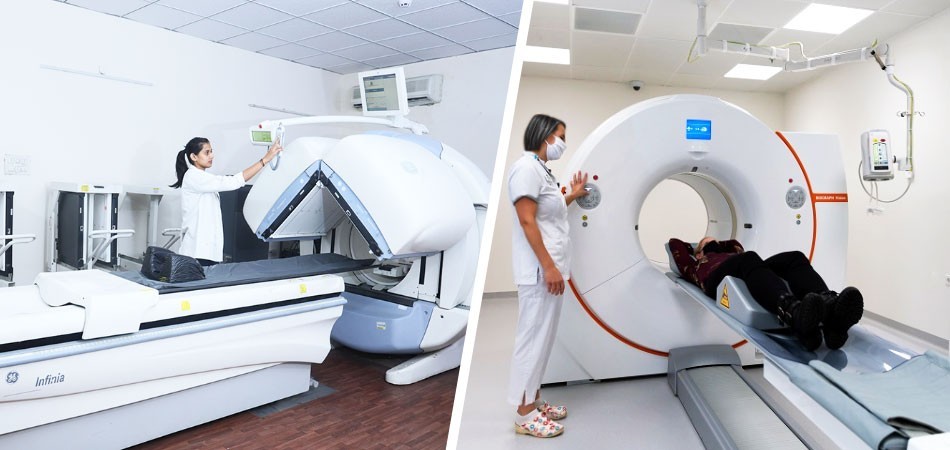Difference Between Gamma Camera and PET Scan in Nuclear Medicine, Under RIT Paramedical Education

Nuclear medicine is also known as Nucleology is a special branch in medical specialty that harbors the use of radioactive pharmaceuticals or medicines in order to diagnose anomalies of the human body as well as functions in the treatment of the pathologies or abnormalities detected. This special branch under radiology combines usage of physics of nuclear, medicine, technology of computer and chemistry in order to produce valuable evaluation about the anatomy and physiological function of organs and tissues.
In Ganesh Paramedical College, we provide training opportunity and facility under Nuclear Medicine in courtesy of the course program, Bachelor of Science in Radiology and Imaging Technology. The nuclear medicine branch duty starts in the beginning of the final year of BRIT course. The duration of the course program is total 3 years inclusive of academics and training.
In this very blog a discussion of comparison in the imaging modality under nuclear medicine specifically gamma camera and PET scan shall be briefly covered. Before getting into that, display of images of the nuclear medicine imaging modalities available that are present are Ganesh Paramedical College are showcased here, which is all the more reason as to why you can trust our organization for a fulfilling career. Here, at Ganesh Paramedical College we focus entirely in providing the best academics and training facility that will enhance and improve towards a successful future.
Both the modalities, gamma camera and PET scan come under imaging techniques of nuclear medicine but there are different principles and purposes involved.
- Gamma Camera can detect the rays of gamma that are emitted by radioactive medicine also known as radioactive tracer. The very medicine is injected into the body of patient that leads to decay of gamma rays or radioactive decay. While that happens, the camera will capture where the tracer is being distributed within the patient body.
- In PET (Positron Emission Tomography) scan, yes there is also the use of radioactive medicine but the medicine that acts as a tracer will work to emit positron and not gamma rays. The working principle of PET scan is that the positron will be emitted and will travel a short distance within the tissue which will then interact with electron and result in the emission of two gamma rays opposite to one another in direction. The PET scanner modality will detect these rays of gamma in order to create images of distribution of tracer medicine.
- In terms of resolution in spatial manner or to simply put image quality gamma cameras consists of lower quality compared to PET scan. Hence for this reason, gamma camera is more suitable to image larger regions or organs instead of detecting smaller abnormality details.
- PET scan do consists of higher spatial resolution which allows the evaluation of smaller structures of abnormalities in greater detail. And for this reason PET scans are able to detect subtle changes in metabolism or function of tissue and organ.
- The common scans of gamma camera are for the heart, kidneys, liver and bones. Also majorly used in procedures like thyroid, renal and bone scans
- The applications of PET scan is rather vast, including cancer imaging that can detect tumors at primary stage, secondary cancer and also is an important tool for the assessment of cancer treatment. PET scan are used in the evaluation of neurological disorders such as Alzheimer disease, tumors present in brain, epilepsy. PET scan is also applied in evaluation of cardiac scans like perfusion and also myocardial viability.
- The radiopharmaceuticals used in gamma cameras are typically technetium 99m, iodine 131 and thallium 201.
- In PET scan, the medicine or tracers that emit positrons are fluorine 18 or F 18, Carbon 11 or C 11, Oxygen 15 or O 15. These are the tracers that get attached to molecules which targets specific tissues or functions of the cells.
- The scan images from gamma camera are interpreted based on the disbursal and intensity of emission of gamma rays that lead to providing information about function and abnormalities of the organ scanned.
- What makes PET scan different is that images interpreted are actually based on metabolic activities of the tissue scan because the tracer or simply radioactive medicines will accumulate in the area where there is higher metabolic rates which ultimately can help in distinguishing and differentiating between healthy and diseased tissue.
FAQ’s on Nuclear Medicine
Is nuclear medicine scan safe?
Yes, nuclear medicine scan is a safe procedure.
Is nuclear medicine scan similar to diagnostic x-ray in terms of radiation?
Yes, NM scan are indeed similar to diagnostic x-rays in terms of radiation because the medicine or radioactive substance used is in a very minute proportion.
How much time do nuclear medicine scan takes to complete?
NM scan can take from 30 minutes to up to 4 hours depending on the scan.
What is PET in nuclear medicine?
PET scan is usually paired with CT or MRI imaging modality to emit positrons via gamma rays as the name suggests, Positron Emission Tomography. PET measures the metabolic activity of the cancer organs or tissues.
Is MRI same as Nuclear medicine?
No, MRI uses non ionizing magnetic field to image organs or body parts whereas, Nuclear Medicine uses ionizing radiation called gamma radiation to evaluate anomalies and its functions.
Conclusion
The Ganesh Paramedical College not only offers top class learning at our institute, but also the best and high tech machines for your comprehensive development. The PET-CT and Nuclear Medicine departments would allow specializing in this field and serving in the one of most competitive environments ahead. We, at Ganesh Paramedical College expect a first-cum first serve basis admissions criteria. For securing your dreams and locking your future with us, contact us on our designated numbers and social media platforms at the earliest. Ganesh Paramedical College, India’s Number 1 paramedical college awaits your presence at our college soon.

